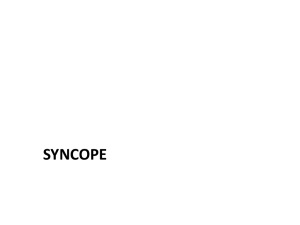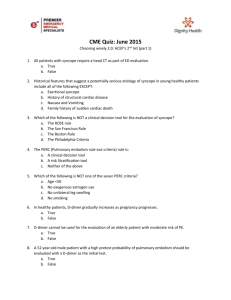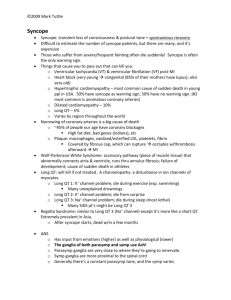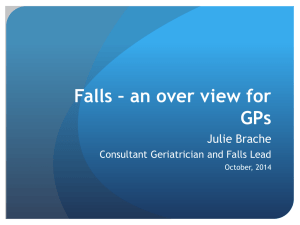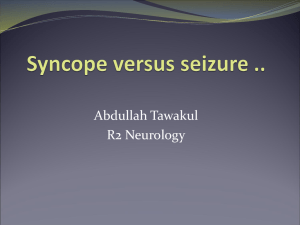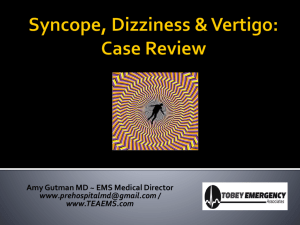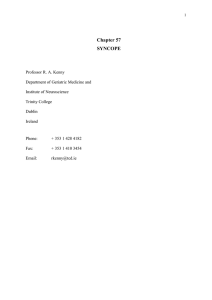slips trips and falls
advertisement
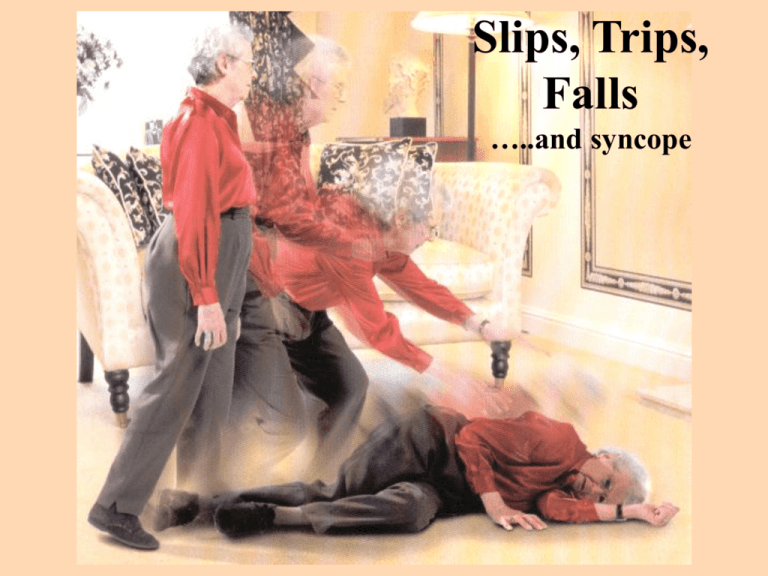
Slips, Trips, Falls …..and syncope Falls - the size of the problem • Each year 30% of those aged over 65, 40% over 80yo living in the community and 60% of nursing home residents will fall (Shaw 1996) • 400,000 older people attend A&E in England because of an accident (DTI 1997, O’Loughlin 1993) • One third of those aged over 50 yrs age attending Newcastle’s A&E do so because of a fall: 10,000 people each year (Richardson 2001). • Older people who have fallen are at risk of falling again. • Many elderly fallers don’t seek help or don’t get further assessed. Falls why bother • Intervention reduces falls and fractures • First indication of undetected illness that is easy to treat It is a miracle we don’t fall more often! Bipedality makes humans inherently unstable. We’d be better as a tortoise! Maintaining an upright position Vision Central processing Vestibular function Muscle strength Joints Sensation Proprioception Changes with age • • • • Postural sway increases (Dheshi 2001) Muscle strength decreases Reaction times slower Vision – Acuity, contrast, depth perception • Disease What happened when you last fell? Consequences that make older adults different from young adults • Risk of fracture increases – less force needed – muscle padding – bone density Loss of confidence Consequences of falling • Hypothermia • pressure related injury • Reduced mobility leading to social isolation and depression • Increased dependency and disability Fear of falling • 30% of older people fear falling (Arfken 1994) • Fear level is greater than the fear of being robbed in the street (Howland 1993) • Associated with older age, poor balance and reduced mobility (Arfken 1994) (Howland 1993) • Psychological barrier to exercise (Bruce 2002) Vicious circle Falls - the size of the problem •15% falls result in serious injury •Leading cause of mortality due to injury in over 75yo in UK (HEA 1999) •5% falls result in fracture 1% hip (Tinetti 1988, O’Loughlin JL 1993) •1/3 hip fractures can no longer live independently and 25% are dead at 6 months •14,000 people die every year from hip # in UK (Melton 1998) Aims of Falls assessment • To prevent further falls • To prevent serious injury - especially fracture Causes of falling are multifactorial, rarely one cause non accidental fallers attending A&E, >50 yo. • In 88% of an attributable cause can be identified • Median number of risk factors 4 – 90% gait – 85% balance – 55% cardiovascular – 45% medications – 30% medical cause – 30% vision – 30% footwear – 10% depression – 10% environment – 10% other Richardson 2001 Identifiable risk factors 400 – Female – Age – Previous fall Risk factors for falling • Intrinsic – – – – – – – – – Muscle weakness Impaired balance Impaired gait Transfer skills • PD, CVA, Degenerative joint disease Impaired cognition Depression Polypharmacy • > 4 drugs, sedatives, hypotensive drugs Postural hypotension Visual impairment Risk factors for falling • Extrinsic – – – – – – – poor lighting especially on stairs steep stairs loose carpets/rugs slippery floors footwear lack of safety equipment inaccesible lights or windows Multiple intervention strategies Proven success in diverse groups – Community based prevention studies in those with 1 or more risk factors (Tinetti 94 Campbell A&A 1999 ) – In residential care after fall (Rubenstein 1990) – A&E attendees (Close 99) – Cognitively impaired fallers attending A&E (Shaw) – No studies reported yet on specifically altering the ‘fear load’ Single intervention studies • • • • Sedative withdrawl (Campbell 99) Enviromental modification (Cumming 99) Exercise programs (Province 95, Campbell 97,99 Robertson 01) Tai Chi - Fear ?? (Wolf 96) Intervention strategies RISK FACTOR • • • • Muscle weakness Impaired balance Impaired gait Transfer skills INTERVENTION • Resistance training • Training, assistive devices • Training, environment • Training, grab rails Intervention strategies RISK FACTOR • >4 prescribed drugs • Sedative use INTERVENTION • Review • Educate, withdraw Intervention strategies INTERVENTION RISK FACTOR • Environmental hazards • • • • • Footwear • New shoes Give Advice Handrails Remove items Secure rugs/carpets Intervention strategies RISK FACTOR INTERVENTION • Visual impairment • Glasses, cataracts • Cognitive impairment • minimise • Depression • treat Intervention strategies RISK FACTOR • Postural hypotension • Carotid sinus syndrome • Vasovagal syncope INTERVENTION Bone protection • Calcium and Vitamin D (Chapuy 92, 94,) – Other effects (Pfeifer 00) • • • • • • Oestrogens Raloxifene Etidronate Alendronate Risedronate Calcitonin – (RCPhys Lon & Bone and Teeth Soc of GB) Hip protectors • In danish nursing homes – 53% reduction in # risk. – Low risk of # if wore garment – compliance 24% - 61%, • Lauritzen 1993, 1996, Kannus 2000. • Recommend use in institutional care, consider in housebound and others with high risk for falls Cardiovascular causes of falls • Neurally mediated syndromes – Othostatic hypotension – Carotid sinus syndrome – Vasovagal syncope – Postprandial hypotension – Situational syncope • • Cardiac abnormalities – Arrhythmias – structual Miscellaneous – PE – TIA – Subclavian steal Why do Syncope and falls overlap • syncope amnesia • cognitive impairment • cerebral hypoperfusion results in gait and balance disturbance Overlap between Syncope and falls • Evidence: • Anecdotal • Case series – 20% of cardiovascular syncope present with falls – Individuals with CSS had reduction in falls as well as syncopal events after pacing • Safe Pace 1 – 2/3 reduction in falls in recurrent unexplained fallers with CICSH after pacing • 3% all falls are syncope (Rubenstein 1996) Overlap between Syncope and falls • Consider in unexplained and recurrent fallers (18% of AE attendees) as 55% have a cardiovascular attributable cause – Especially with significant injury – or a prodrome of ‘dizziness’ – or if lack of recollection how ended up on the ground What is Carotid sinus hypersensitivity? • Defined as > 3secs asystole (cardioinhibitory) &/or >50mmHg fall in SBP (vasodepressor) At carotid sinus massage • The cause of symptoms in 30% of elderly people with syncope • If witnessed to syncope during Carotid sinus massage, and cardioinhibition documented 90% chance that pacing will abort events How do you do carotid sinus massage? • Carotid sinus is located at junction of int and ext carotid arteries, 2fb below jaw level of thyroid cartilage. ECG (and BP monitoring) • Massage carotid sinus for 5secs on each side right and left supine and then erect. 30% CSH missed in supine alone Case History Two Carotid Sinus Massage, Right Supine baseline 133/49 69/24mmHg 5.2s Onset of CSM 5.2 secs of asystole with brief LOC 64mmHg vasodepression no awareness to LOC Contraindications to CSM 1:2000 risk of TIA, 1/8000 risk of CVA Characteristics of patients with complications over 80 years, cardiovascular and cerebrovascular co-morbidity Davies and Kenny, Am J Card 1998, Munro and Kenny, JAGS 1994 • • • • • History of ventricular tachycardia Cerebrovascular event within 3 months Myocardial infarction within 3 months Carotid bruit present Lack of consent Orthostatic (Postural) hypotension diagnosis The Active Stand test • • • • • • • Morning 10 minute rest Anaeroid sphygmanometer is sufficient May need two or even three people Rapid stand Repeated BPs over 2-3 minutes Repeat measurements may be needed, orthostatic response variable time of day and day to day • Beat to Beat BP monitoring facilitates detection Orthostatic hypotension definition? • 20mmHg fall in systolic blood pressure OR 10mmHg fall in diastolic blood pressure within 2 minutes of standing Don’t forget rare causes of OH • Illness – Fever, dehydration, acute blood loss and anaemia – Prolonged bed rest • Inadequate fluid intake • Culprit medications 28% • Age related 20% • Autonomic failure: - if no clear explanation consider AFTs – Primary 24% – MSA 13% – Diabetes 3% – PD 5% • Cardiovascular disease 5% • Addisons - worth checking cortisol/ synachten test • Undiagnosed 2% Orthostatic hypotension non drug management for all.. • Conservative advice – – – – – – – Fluids Take time Exercise pre stand Heat Alcohol Large CHO meals Don’t strain at stool No Crossed legs, squat Salt Sit to wee. • Cognaisance of precipitating factors • Graduated compression stockings/tights • Abdominal binders OH Management refractory cases • • • • Caffeine 2 cups in the morning Raise head end of bed (RAS activation) Bannister 1969 Abdominal binders Specific drugs – – – – – Fludrocortisone Midodrine NSAIDs SSRIs Others Vasovagal syncope Diagnosis • History • Head up tilt test Feeling a bit overwhelmed? The next faller…. Guidelines for the prevention of Falls in Older persons consensus group JAGS 2001 Periodic case finding in primary care ask all patients about falls in last year No falls No problem Recurrent falls Patient presents to medical facility after a fall Single fall Fall Evaluation Check for gait and balance problem gait and balance problems Fall Evaluation Assessment Mutifactorial intervention as appropriate History Gait, balance and exercise programs Medications Medication modification Vision Postural hypotension Gait and balance modification Neurological Environmental hazard modification Cardiovascular Cardiovascular disorder treatment Crucial resources NSF For older people DOH website/by post Guidelines for the prevention of Falls in Older persons JAGS 2001;49: supplement No 5.
